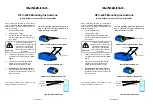
2.2 Diagnostic Trouble Codes (DTCs)
OBD II Diagnostic Trouble Codes are codes that are stored by the on-board computer
diagnostic system in response to a problem found in the vehicle. These codes identify a
particular problem area and are intended to provide you with a guide as to where a fault
might be occurring within a vehicle. OBD II Diagnostic Trouble Codes consist of a
ve-digit alphanumeric code. The rst character, a letter, identies the control system
which sets the code. The other four characters, all numbers, provide additional
information on where the DTC originated and the operating conditions that caused it to
set. Here below is an example to illustrate the structure of the digits:
DTC
Example
P 0 2 0 2
Systems
B=Body
C=Chassis
P=Powertrain
U=Network
Code Type
0=Generic
1=Manufacturer
Specic
Sub-systems
1=Fuel and Air metering
2=Fuel and Air metering
3=Ignition System or
Engine Misre
4=Auxiliary Emission
Controls
5=Vehicle Speed Control
and Idle Controls
6=Computer Output Circuits
7=Transmission Controls
8=Transmission Controls
Identifying Specic
Malfunctioning Section
of the Systems
2.3 Location of the Data Link Connector (DLC)
The DLC (Data Link Connector or Diagnostic Link Connector) is the standardized
16-cavity connector where diagnostic scan tools interface with the vehicle's on-board
computer. The DLC is usually located 12 inches from the center of the instrument panel
(dash), under or around the driver’s side for most vehicles. For some Asian and
European vehicles, the DLC is located behind the ashtray and the ashtray must be
removed to access the connector. Refer to the vehicle’s service manual for the location
if the DLC cannot be found.
- 2 -


































